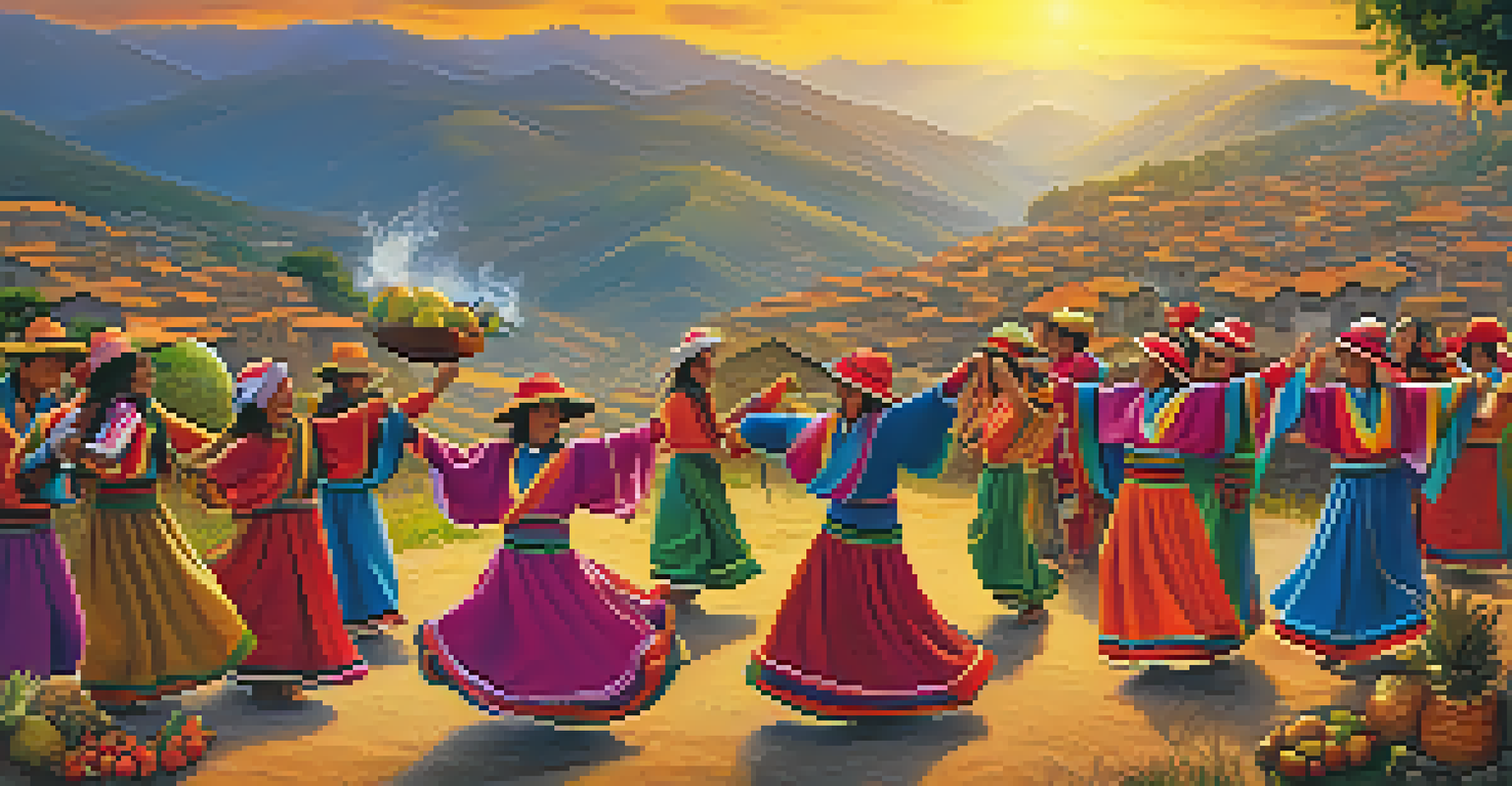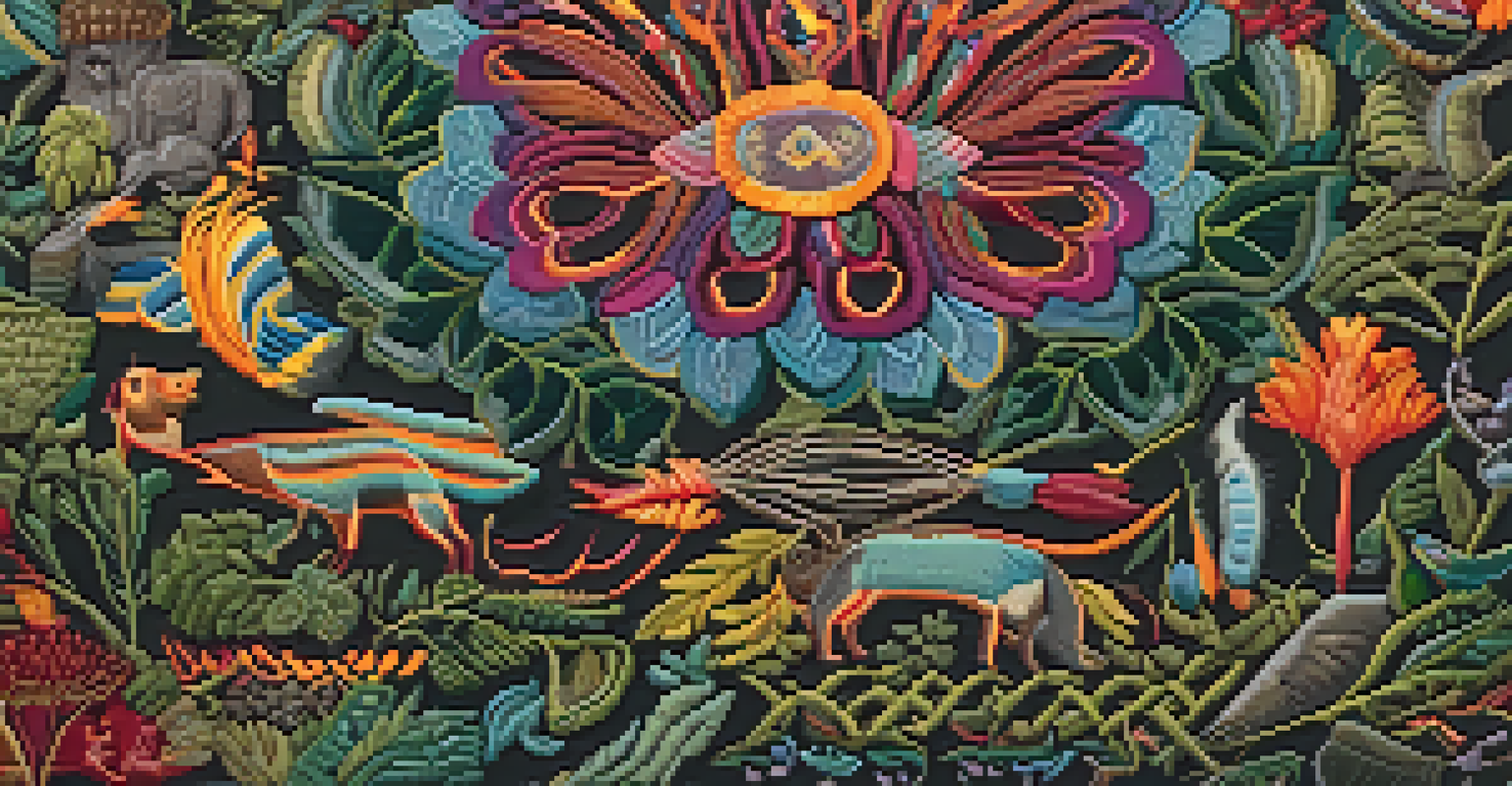The Story of Pachamama: Goddess of Earth in Peruvian Culture

Introduction to Pachamama: Earth's Nurturing Goddess
Pachamama, the revered goddess of earth in Peruvian culture, embodies the nurturing spirit of nature. Her name translates to 'Mother Earth' in the Quechua language, reflecting her role as a provider and protector. From the high Andes to lush valleys, she is celebrated for her ability to sustain life through fertile soil and abundant resources.
The earth does not belong to us; we belong to the earth.
In many Andean communities, the relationship with Pachamama is deeply spiritual, often resembling a familial bond. People believe that by honoring her, they can ensure a harmonious existence with nature. This connection is woven into the fabric of daily life, influencing agricultural practices, festivals, and rituals.
Pachamama's significance extends beyond mere sustenance; she symbolizes the interconnectedness of all living things. Embracing her teachings can inspire us to treat our environment with reverence, fostering a sense of responsibility towards our planet.
Pachamama's Origins and Historical Significance
The worship of Pachamama dates back to ancient civilizations in the Andes, where indigenous peoples recognized her as a central figure in their mythology. Pre-Incan societies, such as the Nazcas and Incas, revered her as a key deity, often associating her with fertility and agriculture. These early cultures understood the importance of nature's cycles and sought to align their lives with Pachamama's rhythms.

As the Inca Empire expanded, Pachamama became integrated into a more extensive pantheon of deities. She was often depicted alongside Inti, the sun god, emphasizing the balance between earth and sky. This duality reflects a holistic worldview, where both elements are essential for life’s continuation.
Pachamama: Mother Earth Symbolism
Pachamama embodies the nurturing spirit of nature, symbolizing the interconnectedness of all living things.
Her historical significance is not just limited to ancient times; Pachamama continues to influence modern Peruvian culture. Many communities still practice ancient rituals, paying homage to her during planting and harvesting seasons, showcasing the enduring legacy of her worship.
The Rituals and Celebrations Honoring Pachamama
Celebrations for Pachamama often involve vibrant rituals that highlight community and gratitude. One of the most notable is the 'Pachamama Raymi,' a festival held every August, where locals offer food, drink, and other gifts to the earth. This event not only strengthens community bonds but also serves as a reminder of the importance of environmental stewardship.
We do not inherit the earth from our ancestors, we borrow it from our children.
During the ritual, participants may perform traditional dances and music, creating an atmosphere of joy and reverence. The offerings, known as 'despachos,' often include products from the land, symbolizing appreciation for the earth’s bounty. This practice reinforces the idea that giving back to Pachamama is essential for maintaining balance.
In recent years, these celebrations have gained international recognition, drawing visitors keen to learn about Andean culture. This growing interest has helped raise awareness about environmental issues, encouraging a broader audience to connect with Pachamama's values.
Pachamama in Contemporary Peruvian Life
In contemporary Peru, Pachamama remains a powerful symbol of resilience and cultural identity. Many Peruvians continue to celebrate their connection to the land through various forms of art, music, and literature. This cultural renaissance highlights the importance of Pachamama as not just a historical figure, but as a living entity that shapes the identity of the people.
The principles associated with Pachamama resonate strongly with modern environmental movements. As issues like climate change and deforestation become increasingly urgent, many draw inspiration from her teachings about sustainability and respect for nature. This alignment underscores the relevance of ancient wisdom in addressing contemporary challenges.
Rituals Celebrate Community and Nature
Festivals like 'Pachamama Raymi' highlight gratitude and environmental stewardship, reinforcing community bonds.
Moreover, Pachamama has transcended borders, influencing global conversations about environmental justice. Her story encourages people worldwide to reflect on their relationship with nature, fostering a collective responsibility to protect the earth.
Symbolism and Art Depicting Pachamama
Artistic representations of Pachamama often capture her nurturing essence and connection to the earth. From vibrant murals in urban areas to traditional textiles in rural communities, her image is a source of inspiration for many artists. These works not only celebrate her but also serve as a form of storytelling, passing down cultural heritage through generations.
In many depictions, Pachamama is shown surrounded by nature—fields, mountains, and animals—emphasizing her role as a life-giver. This symbolism resonates with the Andean concept of 'ayni,' which refers to the reciprocal relationship between humans and nature. Through art, the values associated with Pachamama are communicated, fostering a deeper understanding of her significance.
Contemporary artists often blend traditional motifs with modern techniques, creating a dialogue between past and present. This fusion not only preserves Pachamama's legacy but also invites new interpretations, allowing her story to evolve while remaining rooted in cultural traditions.
The Global Influence of Pachamama's Legacy
Pachamama's influence has reached far beyond the borders of Peru, resonating with various cultures around the world. Her teachings about the interconnectedness of life and the importance of environmental stewardship have inspired movements advocating for sustainability. As people become more aware of ecological issues, they often turn to ancient wisdom for guidance.
In recent years, the concept of Pachamama has been embraced by environmental activists, indigenous rights advocates, and spiritual seekers alike. Many see her as a symbol of resistance against exploitation and a call to honor the earth. This global recognition highlights the relevance of her teachings in a rapidly changing world.
Pachamama's Global Influence
Her teachings on sustainability inspire global movements advocating for environmental justice and indigenous rights.
Moreover, the rising interest in Pachamama has led to dialogue about indigenous rights and environmental justice. Her story serves as a reminder that the fight for the earth is intertwined with the fight for cultural dignity, emphasizing that honoring nature means honoring the people who have cared for it for generations.
Conclusion: Embracing Pachamama's Teachings Today
As we reflect on the story of Pachamama, it's clear that her teachings hold valuable lessons for our modern lives. By embracing her principles of gratitude, reciprocity, and stewardship, we can cultivate a deeper connection with nature. Whether through small daily actions or larger community initiatives, honoring Pachamama encourages us to live sustainably.
Moreover, Pachamama's legacy invites us to appreciate the beauty and complexity of the natural world. In a time when environmental issues are at the forefront of global discussions, her message is more urgent than ever. By integrating her teachings into our lives, we can foster a culture of respect and care for the earth.

Ultimately, the story of Pachamama is not just about the past; it’s a call to action for the future. By nurturing our relationship with the earth, we can honor her legacy and ensure that her gifts continue to sustain generations to come.